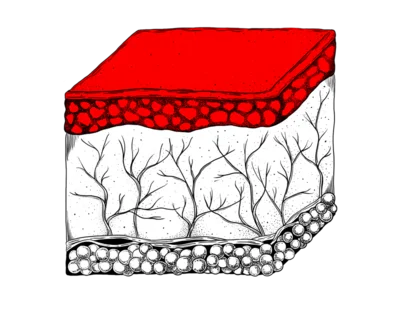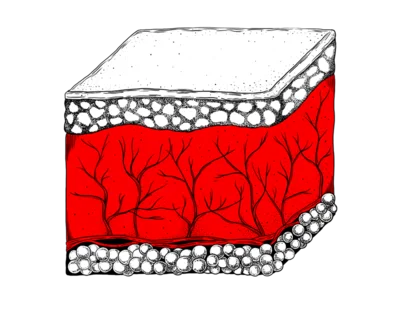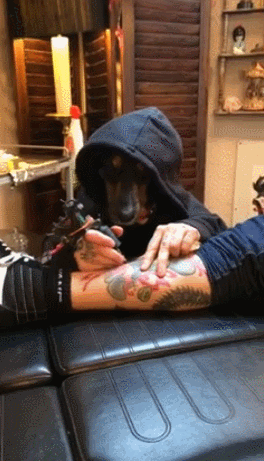What exactly happens during a tattoo and what do you need to know about tattoo colors?
What exactly happens with a tattoo and what do you need to know about tattoo colors? What is actually the tattoo color? How does the color stay in the skin? How do tattoos change the skin? Beiersdorf’s skin researchers have been studying tattooed skin and its care needs for many years and report their findings here.
Wondering how to properly care for a freshly stung tattoo? Here are the dos & don`ts
What would you like to know?
01 | What exactly happens during tattooing?
02 | What are tattoo inks made of?
03 | What happens to the tattoo color after tattooing?
04 | What causes tattoos to have different color perceptions?
05 | How do tattoos change the skin?
06 | What is the difference between a temporary tattoo and a permanent tattoo?
What exactly happens during the tattooing?
Once you’ve decided on your favorite pattern, it’s time to get started: when tattooing, you use needles of different sizes and shapes to prick the tattoo ink into the deepest two millimeters of the skin – through the top layer of skin (epidermis) to the leathery skin underneath (the dermis).
The color pigments are then stored in the dermis for a long time. Some of the color that has entered the epidermis during tattooing disappears again through the natural renewal process of the skin. This takes about three to four weeks. So this “fading” is a completely natural process and does not mean that your tattoo artist did a bad job.
What are tattoo inks made from?
Commercially available tattoo inks consist of a mixture of solid and liquid components. The solid part consists of pigments in the form of tiny particles that are not visible to the naked eye. These pigment particles (e.g. black, red, green, blue) are responsible for the corresponding color of the tattoo. The liquid part consists mainly of solvents, preservatives and various auxiliary substances.
If you are allergic to one or more of these ingredients, the components of the tattoo ink can cause an allergic skin reaction. Talk to your tattoo artist about the tattoo inks used in the studio and take a photo of the ink manufacturer’s ingredients just in case. There you will also find the product number (badge code).

What happens to the tattoo color after tattooing?
You may have noticed that the ink sticks to the tattoo wound dressing. This is because, during the healing process of the tattoo, some of the color is lost to the outside. This also discolors the crust that forms as it heals. Don’t worry, this is completely normal.
For the skin, the tattoo color is initially a foreign body that must be broken down again. Thus, during wound healing, a large part of the tattoo ink is transported away via the lymphatic system – especially the smaller pigments as well as soluble components and auxiliary substances. Part of the tattoo ink, mainly the larger pigments, remain in the skin (dermis) and are thus the core of the tattoo.
In which skin layer does the color pigment stay?
01 | DIE EPIDERMIS (OBERHAUT)

02 | THE DERMIS (LEATHER SKIN)
The dermis contains a dense system of collagen, proteoglycans and elastic fibers that ensure the tear resistance and elasticity of the skin and support the skin cells in their network of collagen fibers. This is where the color pigments used for permanent tattoos are stored. The dermis is also traversed by blood and lymph vessels. In addition to sweat glands, there are hair follicles with sebaceous glands and a large number of immune cells that play an important role in wound healing after tattooing.

THE SUBCUTIS (SUBCUTANEOUS TISSUE)
The subcutaneous tissue consists mainly of adipocytes and connective tissue.

How much pigment remains in the skin?
Depending on the tattooing technique and the tattoo ink used, the amount of color pigments varies. However, the original concentration of pigment particles can be reduced by up to 80% in a short time. This reduction happens through
Washing out during natural wound healing (wound exudate) of the tattoo.
Ultraviolet rays can destroy color pigments.
Removal via the lymphatic system.
The remaining colored pigment particles form the color that makes the tattoo. UV protection and a strengthening of the collagen fiber network with special tattoo anti-aging products ensure that the skin is strengthened and your tattoos retain their color brilliance and expressiveness for a long time.
What causes different color perceptions in tattoos?
The light provides a different perception of the tattoo color. When it falls and penetrates the skin, it is absorbed by pigment particles embedded in the skin.If the pigment absorbs light across the entire visible spectrum, the result is a black tattoo for the viewer. If only part of the visible light is absorbed, the result is a colored tattoo from blue to yellow to green and red. Through the regular use of special tattoo care and UV protection products, you ensure that the color brilliance of your tattoo is maintained for a long time.
Do tattoos change the skin?
To date, there is little scientific research on skin changes caused by tattoos. Repeated reports include higher sensitivity, increased sensitivity to sunlight and light, and a tendency to itch.
Contrary to some opinions, your ability to sweat isn’t actually limited by a tattoo. If you have large, and dark tattoos, the tattooed skin can get very hot in the sun. That’s why your tattoo needs skin-soothing products and highly effective UV protection.
What is the difference between a temporary tattoo and a permanent tattoo?
Bei der Verwendung eines Airbrush- oder Henna-Tattoos wird die Farbe nur auf die Oberfläche aufgetragen. Bei gesunder Haut erneuern sich die Zellen der obersten Hautschicht (Epidermis) etwa alle drei bis vier Wochen. Sie wandern von unten nach oben aus der sogenannten Basalzellschicht und gehen schließlich als Hornzellen ab. Durch diesen natürlichen Vorgang gehen auch die angefärbten Hautzellen der temporären Tätowierung verloren.
Auch bei Permanent-Tattoos dringen die Pigmente zunächst in die Epidermis ein – bleiben dort aber aufgrund des natürlichen Erneuerungsprozesses der Haut nicht lange. Daher liegt bei permanenten Tattos die Epidermis immer wie ein Transparentpapier über dem Pigment, das fest in der Dermis eingebettet ist. Deswegen sind Tattoos nach der Wundheilung immer blasser als direkt nachdem Stechen. Die tägliche Pflegeroutine mit spezieller Tattoo Creme sorgt dafür, dass diese oberste Hautschicht glatt bleibt und dein Tattoo dauerhaft gut aussieht.

